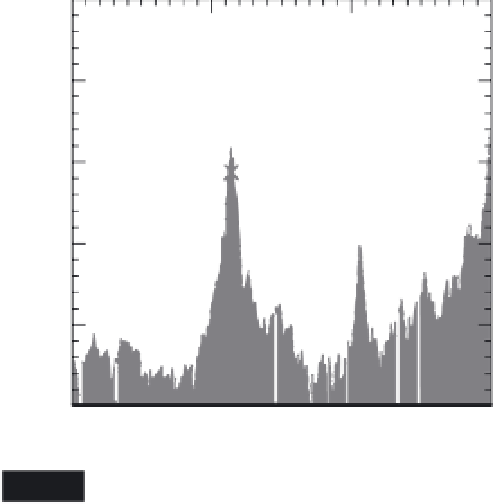Geoscience Reference
In-Depth Information
heat up by conduction from the surrounding hot-
ter mantle and will eventually melt.
MORB--eclogite contains stishovite at high
pressure and may sink below 500 km. Some
low-MgO-arc eclogites have comparable densities.
Note that the deeper eclogite layers form substan-
tial low-velocity zones. The stratification shown
in the figure is only temporary. Subducted or
delaminated material warms up by conduction of
heat inward from ambient mantle. Eclogites have
much lower melting points than peridotites and
will eventually heat up and rise, even if they are
not in a TBL, creating a sort of
yo-yo
or
lava-lamp
tectonics
. The
ilmenite
form of garnet and enstatite
is stable at low temperature but will convert to
more buoyant phases as it warms up. Whole man-
tle convection or vigorous mantle convection,
and entrainment, are not necessary in order to
bring fertile material into the shallow mantle.
Precursors to P'P'
0.05
P'660P'
P'410P'
0.04
long-period
reflection
amplitudes
0.03
0.02
0.01
0
−
200
−
150
−
100
−
50
Time relative to P'P' (sec)
Fig. 9.3
Stacked seismograms of P
P
precursors showing
the major seismic discontinuities and many minor ones (Xu
et al.
, 2003).
Multiple mantle discontinuities
The classical 1D seismological models of the man-
tle include a TR between 400 and 1000 km --
separating the upper and lower mantles -- that
was attributed to phase-changes. Early investi-
gators, using reflected phases and breaks in
teleseismic travel time curves identified many
discontinuities and some of the early seismic
models consisted of layers rather than smooth
variations with depth. Whitcomb and Anderson
(1970), using precursors to the seismic phase P
P
,
identified about six seismic discontinuities in the
mantle; a major one near 630 km depth and oth-
ers at 280, 520, 940, 410 and 1250 km. Although
the attention of geochemists and geodynamicists
has been focused on the better known 410 and
650 km features, there are about 10 discontinu-
ities in the mantle that have now been identified
by seismologists by a variety of high-resolution
or correlation techniques. Systematic searches for
mantle discontinuities have yielded reflections
or conversions from depths of 220, 320, 410,
500--520, 650--670, 800, 860, 1050, 1150--1160 and
1320 km. A survey of many such studies shows
that most of the reflections and conversions
occur in the depth intervals of 60--90, 130--170,
200--240, 280--320, 400--415, 500--560, 630--670,
800--940, 1250--1320 and 2500--2700 km. Some of
these are probably chemical in nature and some
apparently are either highly variable in depth or
are independent scatterers (the reports of reflec-
tions or scatterers between 800 and 1320 km may
all be due to a single highly irregular interface).
The shallow features may represent boundaries
between depleted and fertile peridotites and par-
tial melt zones. Deeper ones may represent slabs
that have been trapped at various depths because
they are too buoyant to sink further.
A number of possible underside reflections
are evident in Figure 9.3. Deuss and Woodhouse
(2002) found a large number of reflections from a
depth of 220 km beneath both oceans and conti-
nents (see Figure 9.4). Altogether, there are more
reflections reported below 650 km and between
410 and 650 km than are reported at 410 and
650 km. These are not so evident in reflection
histograms because they occur over a wide range
of depths as expected for chemical interfaces.
Deep low-velocity zones
Figure 9.2 predicts the presence of low-velocity
zones in a petrologically stratified mantle. Some
eclogites create a LVZ having velocities about
2--5% lower than the surrounding mantle or man-
tle of the same density. The deeper eclogite LVZs







